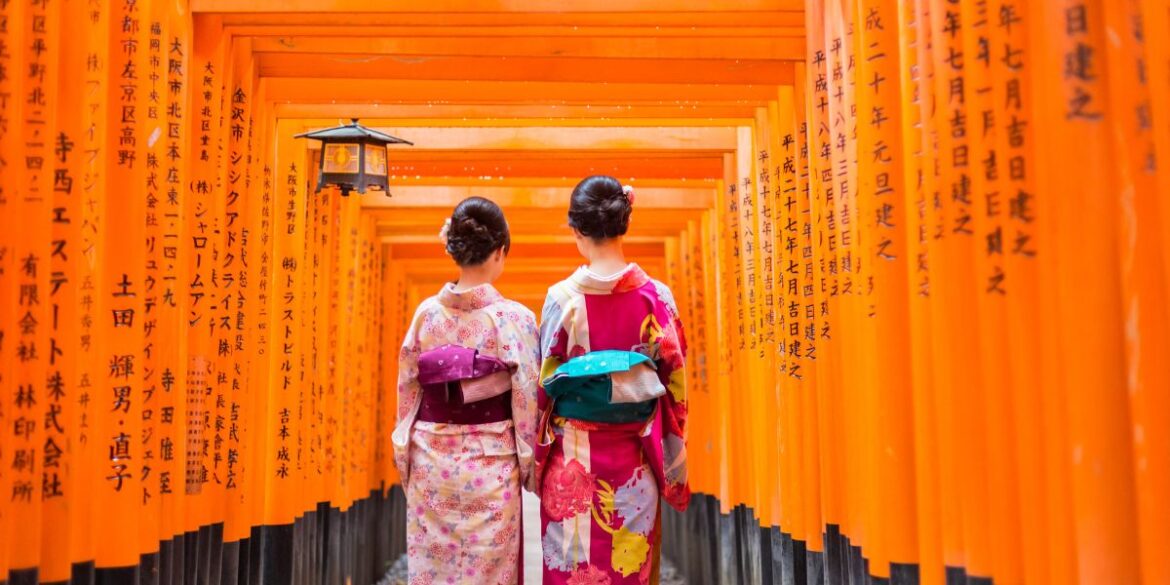The Most Famous and Historic Shinto Shrines and Japanese Temples to Visit This Year
No matter where in Japan you find yourself, it’s impossible to miss the peaceful and majestic Shinto shrines that can be found dotting the landscape.
These religious structures are an important part of Japanese culture and history and offer a unique experience for visitors. If you’re interested in learning more about Shinto shrines or planning a visit, read on for a guide on what to expect, how to visit (including guided tours) and ten must-see Japanese temples and shrines!
1. Meiji Shrine, Tokyo
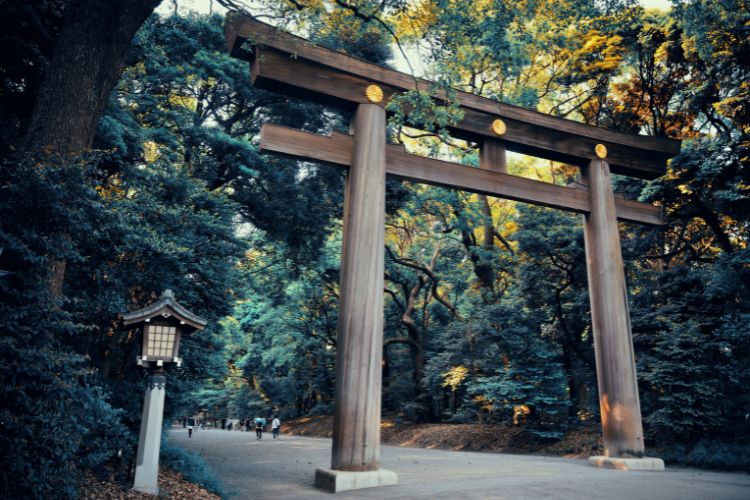
Meiji Shrine, nestled in the bustling heart of Tokyo, Japan, is a sanctuary of tranquility and reverence amid the urban expanse. Dedicated to the deified spirits of Emperor Meiji and his consort, Empress Shoken, the shrine stands as a testament to Japan’s rich history and cultural evolution. Emperor Meiji, who reigned from 1867 to 1912, is celebrated for his role in the Meiji Restoration, an era that saw the rapid modernization and westernization of Japan. This shrine, therefore, is not just a place of spiritual significance but also a monument to progress and enlightenment.
Constructed in 1920, Meiji Shrine is an exemplar of classical Japanese Shinto architecture, designed to harmonize with the natural environment. Its buildings are made from Japanese cypress (hinoki), sourced from the Kiso region, and feature copper roofs that age to a verdant patina, further blending with the surrounding woods. Unlike the misconception of a large statue of Emperor Meiji within the main worship hall, Shinto shrines typically eschew large anthropomorphic representations of the kami (deities or spirits) to whom they are dedicated. Instead, the shrine’s spiritual essence is embodied through its sacred objects and the reverence of its visitors.
The treasure house, or Homotsuden, is a highlight, housing personal belongings of Emperor Meiji and Empress Shoken, offering insights into their lives and the era they symbolize. These artifacts, ranging from formal attire to gifts from international dignitaries, narrate the story of Japan’s engagement with the wider world during a pivotal time in its history.
The shrine’s grounds are expansive, encompassing lush, meticulously maintained gardens that invite contemplation and leisure. These gardens are an integral part of the shrine’s allure, featuring seasonal flowers, ancient trees, and tranquil ponds. Notably, the inner garden, or Yoyogi Gyoen, contains a variety of trees that were planted by the Emperor and Empress themselves, symbolizing growth and renewal. This space provides a serene retreat from Tokyo’s urban intensity, allowing visitors to immerse themselves in natural beauty and tranquility.
- Open: Daily from sunrise to sunset
- Admission: Free
- Address: 1 Chome-18-20 Jingumae, Shibuya City, Tokyo 150-0001, Japan
- Phone: +81 3-3379-5511
Got time for a quick side trip in Tokyo? Schedule a Tokyo Asakusa Rickshaw Tour with Ebisuya for an unforgettable exploration of Asakusa’s unique blend of the old and new. Witness the seamless integration of serene maple and cherry gardens against the backdrop of Tokyo’s skyscrapers. This customizable tour immerses you in Asakusa’s eclectic mix of retro vibes, spiritual sites, and cultural richness. Discover the area’s history with visits to the Ushijima Shrine and Honryuin Matsuchiyama Shoden, unwind in a picturesque Japanese garden featuring the Lucky Fortune Cow Shrine, and catch a glimpse of the Asahi beer headquarters. Experience the thrill of navigating through the streets in a rickshaw, taking in the architectural marvels and historical dwellings from the Edo period.
Book your Tokyo Asakusa Rickshaw Tour with Ebisuya on Viator here. Free cancellation up to 24 hours before, reserve now and pay later.
2. Fushimi Inari Taisha Shrine, Kyoto
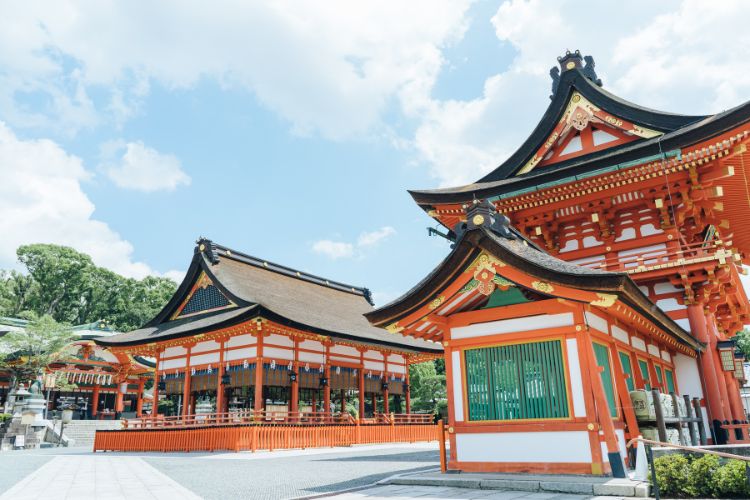
Fushimi Inari Shrine, a venerable and esteemed sanctuary, stands as a tribute to Inari, the Shinto deity revered for overseeing rice, agriculture, and commerce. Established in 711 AD, its location in Kyoto, Japan, makes it a pivotal cultural and spiritual landmark. The shrine is dedicated to ensuring prosperity and success in these vital aspects of Japanese life, reflecting the country’s deep-rooted agrarian traditions and the significance of rice as a foundational staple.
Central to Fushimi Inari Shrine’s allure are the fox statues that dot its landscape. In Shinto belief, these foxes serve as messengers for Inari, embodying the deity’s presence and providing guidance to the faithful. They are often depicted holding symbolic items such as keys to the rice granary, a sheaf of rice, or a precious jewel, underscoring their protective and benevolent roles in ensuring bountiful harvests and general well-being.
The shrine complex itself spans an expansive area, offering a network of trails that meander up the sacred Mount Inari. It’s famed for its thousands of vibrant vermilion torii gates, which create an immersive and captivating experience as they arc over the pathways, leading visitors through the mountain’s serene, forested landscape. These gates, known as Senbon Torii, signify the gateway between the physical and spiritual worlds and are donated by individuals and businesses seeking blessings for prosperity.
Unlike the mentioned main hall housing a large statue of Inari, Fushimi Inari Taisha (the shrine’s formal name) focuses on open-air worship spaces and does not centralize around a singular, anthropomorphic representation of Inari. Instead, the spiritual essence of Inari is encapsulated through the fox statues and the sacred architecture that harmonizes with the natural beauty of the surroundings. The shrine complex includes numerous smaller shrines and structures, each offering a unique glimpse into the practices and traditions of Shinto worship.
- Open: Daily from sunrise to sunset
- Admission: Free
- Address: 68 Fukakusa Yabunouchicho, Fushimi Ward, Kyoto, 612-0882, Japan
- Geographic Coordinates: 34°58′2″N 135°46′22″E / 34.96722°N 135.77278°E
- Phone: +81 75-641-7331
If you’re unsure about how to experience Kyoto properly and would like to arrange a private and customizable tour of some of the city’s most historic sites, including the Inari Shrine, maximize your Kyoto adventure with The Early Bird Tours’ exclusive half-day private excursion. Tailor your journey to fit your unique tastes, crafting a bespoke itinerary that can include the enchanting streets of Gion, the serene Philosopher’s Path, or the majestic sights of Ryoanji and Fushimi Inari-taisha. Wander amidst the towering stalks of the Bamboo Forest Street or delve into the heart of Kyoto’s most revered shrines and temples. Navigate the city like a local, utilizing an array of public transport options—from buses and trains to the metro—guided every step of the way by your personal guide. Dive deep into the culture and history of Kyoto with insightful commentary, ensuring a rich, fulfilling experience. Embark on this personalized tour and see the best of Kyoto in just half a day, leaving ample time to explore further at your leisure.
Book now with The Early Bird Tours and secure your spot on this custom-tailored journey, designed exclusively for you.
3. Ise Shrine (Ise Jingu), Mie
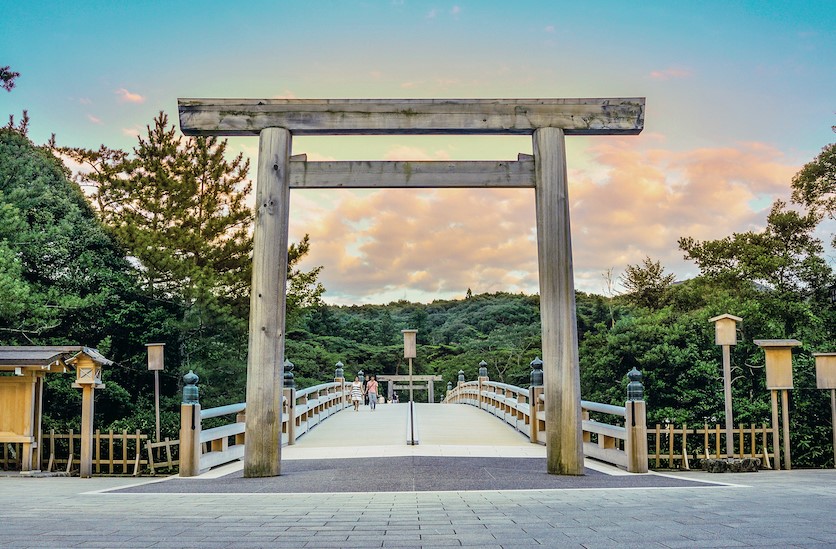
Ise Shrine, known in Japanese as Ise Jingu, holds a preeminent place in the spiritual landscape of Japan, revered as the most sacred shrine in the nation. Dedicated to Amaterasu-Omikami, the sun goddess and mythical ancestress of the Imperial family, it serves as a cornerstone of Shinto belief, embodying the deep connection between Japan’s natural beauty, spiritual traditions, and imperial history.
Located in the city of Ise in Mie Prefecture, this shrine complex is an architectural marvel, encompassing a vast area with over 125 shrines, including the Naiku (Inner Shrine) and Geku (Outer Shrine), along with auxiliary buildings and pristine gardens that are meticulously cared for, reflecting the Shinto emphasis on harmony with nature. The shrine’s significance extends beyond its religious implications, serving as a cultural heartbeat for the nation and a place of pilgrimage for millions of visitors each year.
The Naiku, or Inner Shrine, is indeed the spiritual core of Ise Jingu, enshrining Amaterasu-Omikami. It is here that the sacred mirror, one of the Three Sacred Treasures of Japan, is housed. This mirror, known as Yata no Kagami, is not merely a religious artifact but a symbol of the divine spirit of Amaterasu, reflecting the purity and wisdom she bestows upon the imperial lineage and, by extension, the Japanese people. It’s important to note that while the sacred mirror itself is not on public display, its presence imbues the Naiku with profound sanctity.
Access to the Naiku is marked by a journey through nature, crossing the Uji Bridge, which is renewed every 20 years in a ritual that symbolizes rebirth and continuity. Visitors are reminded of the deep respect accorded to this sacred space through protocols such as the prohibition of photography, inviting a focus on introspection and reverence.
Beyond the Naiku, the Geku (Outer Shrine) is dedicated to Toyouke Omikami, the deity of agriculture and food, highlighting the intrinsic link between the divine, the natural world, and the sustenance of life. The practice of Shikinen Sengu, the ceremonial reconstruction of the shrine buildings every 20 years, reflects the Shinto principles of impermanence, renewal, and the eternal cycle of nature. This tradition, involving the transfer of the deities to new structures, ensures that the techniques and materials of ancient Japanese architecture are preserved and passed down through generations.
- Open: Daily from sunrise to sunset
- Admission: Free
- Address: 1 Ujitachicho, Ise, Mie 516-0023, Japan
- Phone: +81 596-24-1111
RECOMMENDED: Explore the Ise Jingu (Ise Grand Shrine) with a half-day private tour offered by Japan Guide Agency, featuring the expertise of a government-licensed guide. This tour provides a focused, in-depth look at one of Japan’s most significant spiritual sites, tailored to meet the specific interests of your group. Gain insights into the shrine’s architecture, the history of Shintoism, and the cultural significance of the surrounding landmarks, including the Meoto Iwa. With personalized attention from your guide, this experience ensures a comprehensive understanding of Japanese traditions and the ancient roots of the Ise Grand Shrine, all within a professional and concise format.
Book your half-day tour of Ise Jingu, free cancellation, reserve now & pay later.
4. Kiyomizu-dera Temple, Kyoto
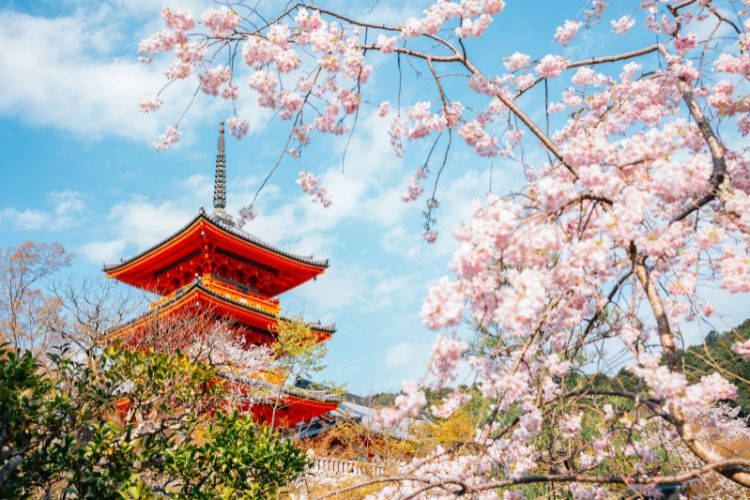
Kiyomizu-dera, a historic Buddhist temple established in 780 AD, stands as a testament to the architectural and cultural depth of Kyoto, Japan. Renowned for its main hall, constructed on a hillside without the use of nails, this temple offers breathtaking views over Kyoto, seamlessly blending spiritual tranquility with natural beauty.
Visiting Kiyomizu-dera during cherry blossom season elevates the experience, as the surrounding gardens and pathways are adorned with the delicate pink hues of blooming cherry trees, creating a picturesque setting that encapsulates the essence of spring in Japan. In addition to the floral spectacle, the temple is home to the Otowa Waterfall, where three streams of water fall into a pond. Visitors often drink from them, as each stream is believed to confer benefits in longevity, success in studies, and a fortunate love life.
The temple’s architecture, particularly the main hall’s expansive wooden stage, projects out over the hillside, offering a panoramic view of the city and the enveloping nature.
- Open: Daily from sunrise to sunset
- Admission: 400 yen (at time of writing)
- Address: 1 Chome-294 Kiyomizu, Higashiyama Ward, Kyoto, 605-0862, Japan
- Geographic coordinates: 34°59′42″N 135°47′06″E / 34.99500°N 135.78500°E
- Phone: +81 75-551-1234
Join JTB Global Marketing & Travel Inc. for an immersive Kyoto Afternoon Tour, a four-hour guided exploration that unveils the heart and soul of Kyoto’s religious and cultural landscapes. This tour includes a visit to the Sanjusangendo Temple, Japan’s longest wooden structure, housing over 1000 statues of Kannon, the Goddess of Mercy. Marvel at the sprawling vermillion gates of Fushimi Inari Taisha Shrine, dedicated to the god of rice and prosperity, and enjoy breathtaking views of Kyoto from the historic Kiyomizu Temple. With all entrance fees included, along with the insights of an informative and friendly guide, this tour offers a comprehensive glimpse into Kyoto’s rich cultural and spiritual heritage, complete with ample opportunities for stunning photographs.
Book your guided tour of Kyoto and its various temples with JTB Global Marketing & Travel Inc.
5. Ginkaku-ji, Kyoto
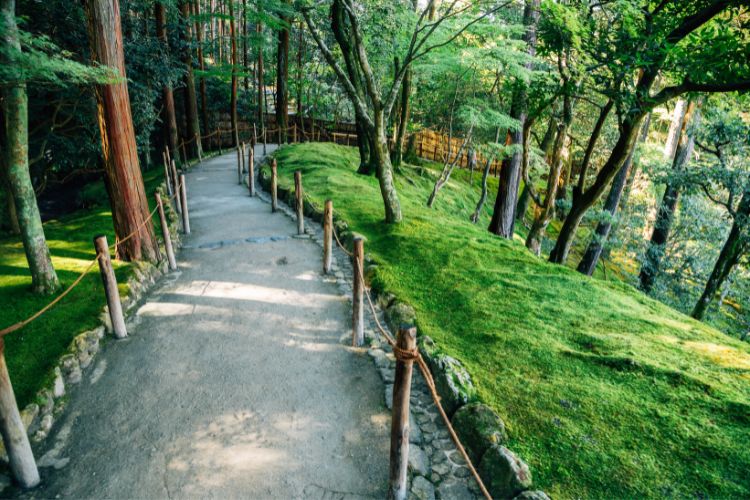
Ginkaku-ji, also known as the Silver Pavilion, is a quintessential example of the refined elegance and profound spiritual ethos that characterize Kyoto’s Zen Buddhist temples. Established in 1482 by Ashikaga Yoshimasa, the eighth shogun of the Ashikaga shogunate, Ginkaku-ji was initially conceived as a retirement villa and later converted into a Zen temple. Contrary to its name, the Silver Pavilion never received a silver facade; instead, it is believed the name emerged metaphorically to contrast with Kinkaku-ji, the Golden Pavilion, reflecting the shogun’s aesthetic aspirations rather than literal decoration.
The architectural composition of Ginkaku-ji harmoniously blends two distinct styles: the shinden-zukuri style, traditionally associated with Heian Period aristocratic residences, is evident in the main hall, embodying a classical elegance that invites contemplation. Meanwhile, the temple’s gardens are a masterclass in karesansui (dry landscape) design, a more modern Zen garden style that uses carefully arranged rocks, gravel, moss, and small shrubs to symbolize water and mountains, offering a minimalist yet deeply evocative natural landscape.
Visiting Ginkaku-ji in autumn is particularly recommended, as the temple’s gardens transform with the vibrant hues of orange and red leaves, creating a stunning visual spectacle that enhances the serene beauty of the surroundings. The cherry blossom season also adds a delicate beauty to the temple, with the pale pink blossoms providing a striking contrast against the temple’s tranquil backdrop.
- Open: Daily from sunrise to sunset
- Admission: 500 yen (at time of writing)
- Address: 2 Ginkakujicho, Sakyo Ward, Kyoto, 606-8402, Japan
- Phone: 81 75-771-5725
6. Kinkaku-ji, Kyoto
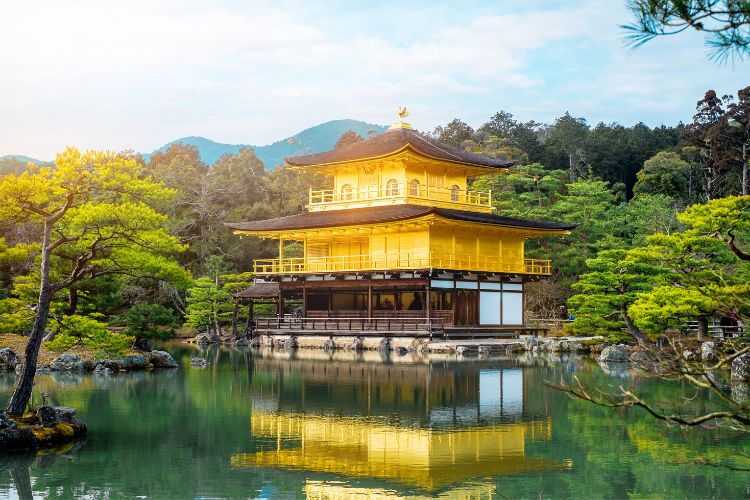
Kinkaku-ji, renowned as the Golden Pavilion, stands as a symbol of Kyoto’s historical and architectural grandeur. Constructed in 1397 as a retirement villa for Shogun Ashikaga Yoshimitsu, it was posthumously transformed into a Zen Buddhist temple, adhering to his will. Unlike its contemplative counterpart Ginkaku-ji, the Silver Pavilion, which remains unadorned, Kinkaku-ji is famous for its striking gold-leaf-coated exterior that reflects beautifully in the pond before it, embodying a luxurious contrast to the more subdued aesthetic of Ginkaku-ji.
The temple harmonizes two architectural styles: the elegant shinden-zukuri, reminiscent of Heian Period aristocracy, and the zen style, which reflects the simplicity and profound depth of Zen Buddhism. This blend of styles creates a complex that is both a feast for the eyes and a sanctuary for contemplation.
The experience of visiting Kinkaku-ji transforms with the time of day. At sunrise, the temple comes alive with eager visitors keen to witness the golden facade’s radiant glow as the first light of day strikes its surface. This moment of communal anticipation and excitement offers a unique way to engage with the temple’s beauty and history. Conversely, sunset at Kinkaku-ji offers a serene and almost solitary experience, allowing for a meditative stroll through its gardens. As the crowds thin and silence descends, the setting sun casts a soft light on the pavilion, enhancing the tranquil atmosphere and providing a moment of peaceful reflection.
- Open: Daily from sunrise to sunset
- Admission: 500 yen (at time of writing)
- Address: 1 Kinkakujicho, Kita Ward, Kyoto, 603-8361, Japan
- Phone: +81 75-461-0013
7. Dazaifu Tenmangu, Fukuoka



Shrine and gardens found at Dazaifu Tenmangu in Fukuoka. Images courtesy Sanga Park / Getty.
Dazaifu Tenmangu, located in Fukuoka, stands as a shrine deeply revered for its dedication to Sugawara Michizane, the god of learning and scholarship. Founded in 920 AD, it has grown to be one of the most celebrated shrines in Japan, particularly among students and academics seeking blessings for success in their studies.
The shrine complex captivates visitors with its exquisite architecture, serene gardens, and a picturesque pond that mirrors the changing seasons around it. At its core, the main hall venerates Sugawara Michizane with a prominent statue, honoring his contributions as a scholar and statesman during the Heian period. Beyond this, the shrine is enriched with a collection of statues and cultural artifacts that narrate the shrine’s storied past and its significance in promoting wisdom and education.
- Open: Daily from sunrise to sunset
- Admission: Free
- Address: 4 Chome-7-1 Saifu, Dazaifu, Fukuoka 818-0117, Japan
- Phone: +81 92-922-8225
8. Toshogu Shrine, Nikko



Scenes of the Toshogu Shrine in Nikko, Japan. Images courtesy Leonid Andronov and Ivan Kokoulin / Getty.
Nikko, located in Tochigi Prefecture, is a town of significant historical and cultural importance, largely due to the presence of the Toshogu Shrine. Established in 1617, Toshogu is a lavishly decorated shrine complex dedicated to Tokugawa Ieyasu, the founder of the Tokugawa shogunate, which ruled Japan from 1603 to 1868. This shrine is a masterpiece of Japanese architecture and is part of the “Shrines and Temples of Nikko,” a UNESCO World Heritage site, recognized for its cultural, historical, and architectural value.
The shrine complex is renowned for its elaborate wood carvings, extensive use of gold leaf, and a blend of Shinto and Buddhist architectural elements. Among its many notable features are the Yomeimon Gate, renowned for its intricate carvings and grandeur, and the famous “See no evil, speak no evil, and hear no evil” monkey carvings, which embody principles of moral behavior in a unique and visually striking manner.
In addition to the architectural marvels, Toshogu is surrounded by well-preserved gardens and a scenic lake, contributing to the site’s tranquil and picturesque setting. These gardens are a testament to Japanese landscape design, offering a peaceful retreat and a chance to reflect amidst nature’s beauty.
While Toshogu Shrine is a popular destination for tourists, attracting large numbers of visitors especially during the summer months, it’s advisable to plan visits during the early morning or late afternoon to avoid the crowds. This timing allows for a more serene exploration of the site’s rich heritage and the opportunity to fully appreciate its artistry and historical significance.
- Open: Daily from sunrise to sunset
- Admission: 1300 yen
- Address: 2301 Sannai, Nikko, Tochigi 321-1431, Japan
- Geographic coordinates: 36°45′29″N 139°35′56″E / 36.758064°N 139.598958°E
- Phone: +81 288-54-0560
Discover more of Nikko’s hidden gems with Japan Awaits’ exclusive half-day tour, tailor-made for guests who wish to explore beyond the famed Toshogu Shrine. Perfect for those already accommodated in Nikko, this personalized journey allows you to craft an itinerary that aligns with your interests. Whether you’re drawn to the UNESCO-listed Toshogu Shrine, the breathtaking vistas of Lake Chuzenji and Kegon Falls, or the immersive experience of theme parks like Edo Wonderland Nikko Edomura, your private guide is there to ensure a seamless adventure. Enjoy the convenience of hotel transfers within Nikko, hassle-free transportation around the town, and the invaluable insights of a guide who’ll handle all reservations. This private tour promises an intimate and enriching exploration of Nikko’s cultural and natural treasures.
Book a custom half-day tour of Nikko with Japan Awaits. Free cancellation, reserve now and pay later.
9. Tsurugaoka Hachimangu Shrine, Kamakura
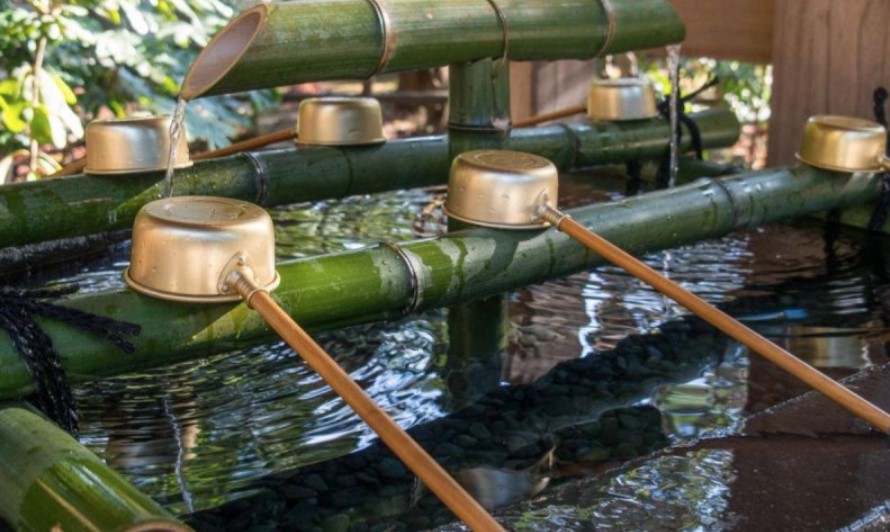
Kamakura, located in Kanagawa Prefecture, is widely recognized for its significant historical sites, particularly its temples and shrines. A notable destination within the city is Tsurugaoka Hachimangu Shrine, which holds great importance in Kamakura’s cultural and religious landscape. This shrine, dedicated to Hachiman, the god of war and patron of the Minamoto clan, was founded in 1185. It plays a central role in the history of Kamakura, reflecting its past as a political and military hub in medieval Japan.
Tsurugaoka Hachimangu is not only a place of worship but also a site of immense historical value, attracting numerous visitors throughout the year. Due to its popularity, it can become particularly crowded during peak tourist seasons. The shrine’s architecture and its approach, a long, wide street that leads directly from Kamakura’s waterfront, are designed to impress visitors with the power and prestige of the Minamoto family and their deity.
Visitors are encouraged to explore the shrine’s expansive grounds, which include several buildings of historical significance, a museum with artifacts related to the shrine and the city’s history, and beautifully maintained gardens. The shrine also hosts various cultural and religious events throughout the year, offering insights into Japanese traditions and practices.
For those planning to visit Kamakura, Tsurugaoka Hachimangu Shrine represents an essential experience, offering a deep dive into the historical roots and spiritual practices of the area. To avoid the crowds and have a more tranquil visit, consider going early in the morning or later in the afternoon, especially outside of holiday periods and weekends.
- Open: Daily from sunrise to sunset
- Admission: Free
- Address: 2 Chome-1-31 Yukinoshita, Kamakura, Kanagawa 248-8588, Japan
- Phone: +81 467-22-0315
RECOMMENDED: Staying in Tokyo? Set off on an unforgettable journey from Tokyo with Gogoday Travel’s Kamakura, Hachimangu Shrine & Enoshima Day Tour. This excursion offers a perfect blend of history, culture, and natural beauty, taking you from the bustling streets of Tokyo to the serene landscapes of Kamakura. Start your adventure with a scenic ride on the historic Enoden Electric Railway, weaving through Kamakura’s picturesque sights along the Shonan coast. Experience the tranquil beauty of the Shonan beach, where the sound of waves and the possibility of glimpsing Mount Fuji set the scene for relaxation. Dive into history at the Enoshima Shrine, admiring its nationally designated cultural treasures, before standing in awe of the majestic Great Buddha, a symbol of Japan’s rich Buddhist heritage. The tour culminates at the Tsurugaoka Hachimangū Shrine, a testament to samurai legacy and spiritual depth, followed by a leisurely stroll down Komachi Street, bridging the gap between Kamakura’s ancient spirit and its vibrant present. With hotel pickup from Tokyo, transport included, and the intimate knowledge of your guide, this day tour promises a comprehensive and enriching exploration of Kamakura’s most cherished sights.
Book a day tour from Tokyo with Gogoday Travel’s Kamakura, Hachimangu Shrine & Enoshima experience.
10. Itsukushima Shrine, Miyajima Island, Hiroshima Prefecture
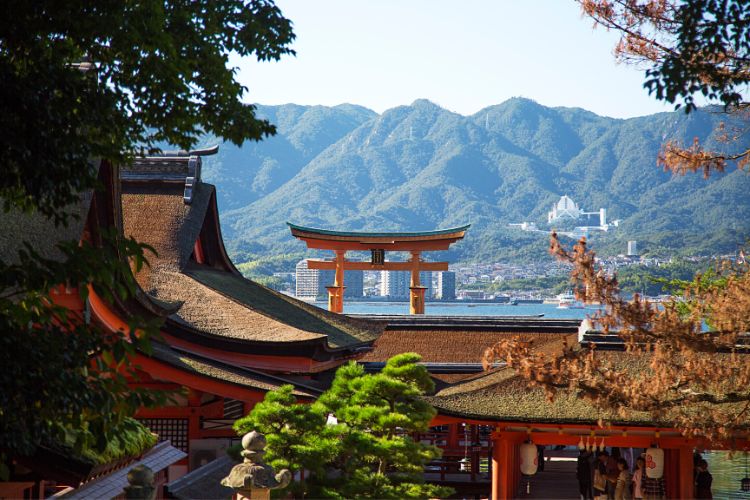
Itsukushima Shrine, a UNESCO World Heritage Site, is renowned for its iconic “floating” torii gate that appears to stand in the middle of the sea during high tide. This shrine, dedicated to the three daughters of Susano-o no Mikoto, Shinto god of seas and storms, and brother of the sun goddess Amaterasu, has been a sacred site since the 6th century, though the current structure dates back to the 12th century.
Visitors to Itsukushima can expect to be mesmerized by the shrine’s unique construction, which is built over water to preserve the island’s purity, believed to be the abode of gods. The shrine complex includes several buildings connected by boardwalks, offering stunning views of the surrounding sea and mountains. The torii gate, accessible by foot at low tide, presents a breathtaking sight and a popular photo opportunity, embodying the harmonious relationship between nature and spirituality that characterizes Shinto belief.
The shrine is also famous for its elaborate rituals and festivals, particularly the Kangensai (music festival), which dates back to the Heian period. Besides its spiritual significance, Itsukushima Shrine offers visitors a chance to explore the rich cultural heritage and natural beauty of Miyajima Island, making it a must-visit destination for those seeking to experience the depth of Japan’s religious traditions and landscapes.
- Open: Daily, hours vary by season
- Admission: 300 yen for adults, with discounts for students
- Address: 1-1 Miyajimacho, Hatsukaichi, Hiroshima 739-0588, Japan
- Phone: +81 829-44-2020
RECOMMENDED: Explore Hiroshima and Miyajima Island with JGA Inc.’s customizable private tour, designed to cater to your unique preferences and schedule. Begin your exploration with a convenient hotel pickup in Hiroshima, guided by an expert who will lead you through a day filled with history, culture, and natural beauty. Your 6-hour itinerary can include the poignant Hiroshima Peace Memorial Park and the iconic Atomic Bomb Dome, offering a deep dive into the events of August 6, 1945, and their lasting legacy of peace. Engage with the powerful exhibits of the Hiroshima Peace Memorial Museum, where artifacts and educational displays recount the tragic history and resilience of Hiroshima. The adventure continues with a scenic ferry ride to Miyajima Island, where you’ll be enchanted by the breathtaking Itsukushima Shrine and its famed floating torii gate, a symbol of harmony between humanity and nature. Customize your tour to ensure a truly personal and unforgettable experience, discovering the soul of Hiroshima and the enchantment of Miyajima Island at your own pace.
Book a private and customizable tour of Hiroshima and Miyajima Island with JGA Inc.
Shrines and Temples Glimmer Down The Backstreets of Japanese Cities
Even if you can’t make it to any of the larger, more famous Japanese temples on this list there might be a shrine or temple just a stones’ throw from where you’re standing.
The calming, spiritual, shrines and temples of Japan can be a wonderful respite from the hustle and bustle of everyday life. No matter where you are in Japan, there is likely a shrine or temple close by that will allow you to escape for a little while, enjoy some peace and meditate on your life.
*Editor’s Note: Opening hours and admission fees accurate at time of writing but are subject to change. Please call ahead to each shrine or temple to confirm for your visit or schedule one of the guided tour options we recommend in this travel guide.
